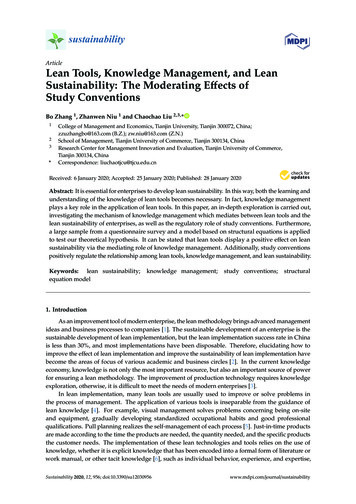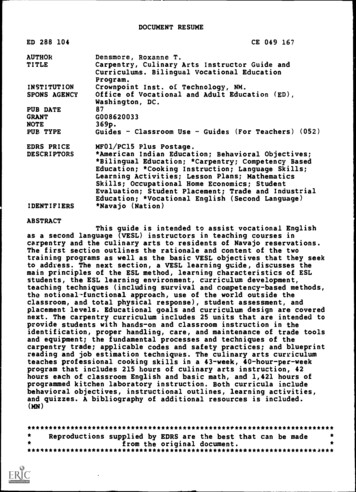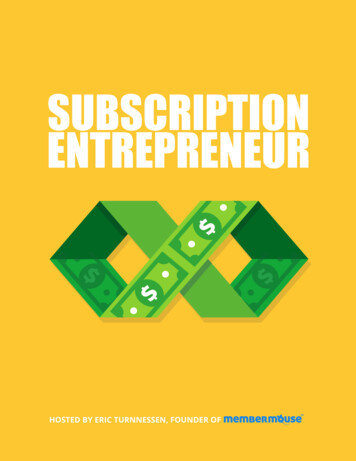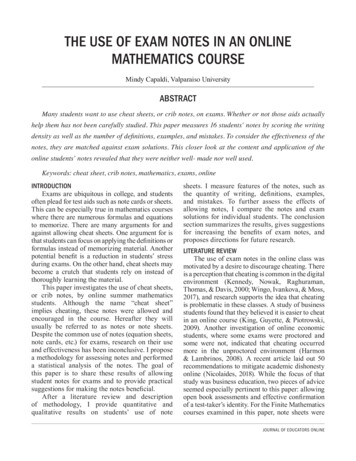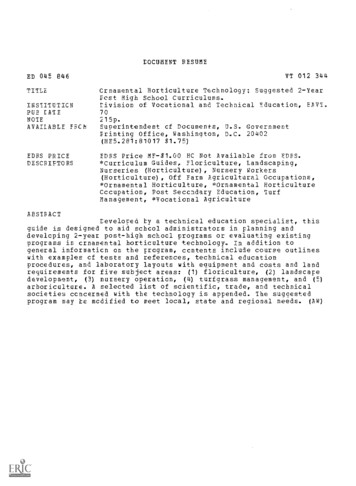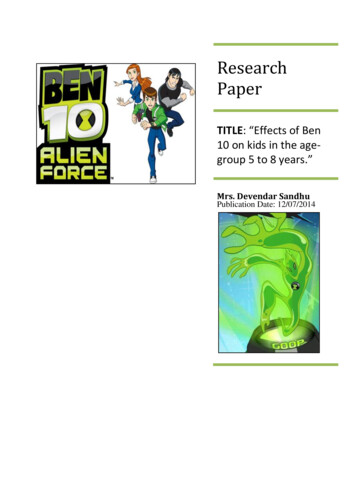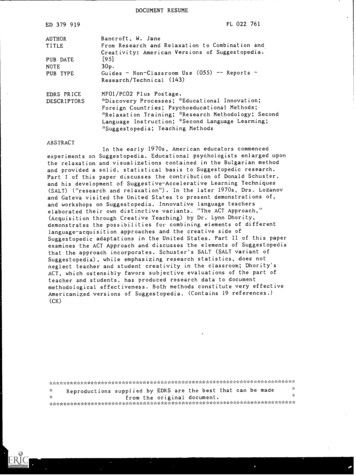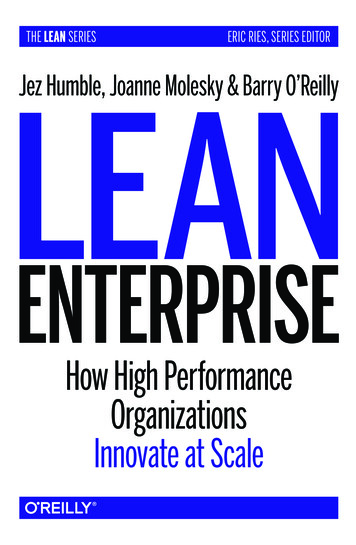
Transcription
THE LEAN SERIESERIC RIES, SERIES EDITORJez Humble, Joanne Molesky & Barry O’ReillyLEANENTERPRISEHow High PerformanceOrganizationsInnovate at Scale
Praise for Lean Enterprise“This book is Reengineering the Corporation for the digital age. It is destinedto be the classic, authoritative reference for how organizations plan, organize,implement, and measure their work. Lean Enterprise describes howorganizations can win in the marketplace while harnessing and developing thecapabilities of employees. Any business leader who cares about creatingcompetitive advantage through technology and building a culture ofinnovation needs to read this book.”— Gene Kim, co-author of The Phoenix Project: A NovelAbout IT, DevOps, and Helping Your Business Win,founder and former CTO of Tripwire, Inc.“This book is a godsend for anyone who’s tried to change their organizationand heard: ‘It’s OK for the little guy, but we’re too big/regulated/complex towork like that here.’ Humble, Molesky, and O’Reilly have written an easy-toread guide that demystifies the success of Lean organizations in a way thateveryone can understand and apply. Lean Enterprise provides a pragmatictoolkit of strategies and practices for establishing high performingorganizations. It should be required reading for every executive whounderstands that we’re all in the technology business now.”— Stephen Foreshew-Cain, COO,UK Government Digital Service“To thrive in the digital world, transformation must be more than technologydriven—everyone within the organization must collectively work together toadapt. This book provides an essential guide for all leaders to change the waythey deliver value to customers.”— Matt Pancino, CEO, Suncorp Business Services“This is the book I’ve been waiting for—one that takes on the hardestquestions in bringing Lean approaches to the enterprise. The authors providesolutions that are valuable even in low trust environments.”— Mark A. Schwartz (@schwartz cio)
“This book integrates into a compelling narrative the best current thinkingabout how to create great software-intensive products and services. Theapproach in this book is both challenging and disciplined, and someorganizations will be unable to imagine following this path. But those whomake the journey will find it impossible to imagine ever going back—and ifthey happen to be a competitor, they are well positioned to steal both yourmarket and your people. Ignore this book at your own risk.”— Mary Poppendieck, co-author of The Lean Mindset andthe Lean Software Development series“My job is to support people in practicing a scientific pattern, to help reshapethinking and working habits in business, politics, education, and daily life. The21st century is increasingly demanding a way of working that’s cognitivelycomplex, interpersonal, iterative, and even entrepreneurial. With LeanEnterprise, Jez Humble, Joanne Molesky, and Barry O’Reilly explain howsoftware can and is leading the way to transforming our ways of working,which can change our ways of thinking and help us adapt to the emergingworld around us.”— Mike Rother, author of Toyota Kata“Nearly all industries and institutions are being disrupted through the rapidadvance of technology, guided by the inspired vision of individuals and teams.This book clearly explains how the disciplines of Lean, Agile, Kata, LeanStartup, and Design Thinking are converging through the unifying principles ofan adaptive learning organization.”— Steve Bell, Lean Enterprise Institute faculty,author of Lean IT and Run Grow Transform“Building software the right way is a challenging task in and of itself, but LeanEnterprise goes beyond the technology considerations to guide organizationson how to quickly build the right software to deliver expected business resultsin a low risk fashion. This is a must read for any organization that providessoftware based services to its customers.”— Gary Gruver, VP of Release, QE, andOperations for Macys.com
“To compete in the future businesses need to be skilled at understanding theircustomers and taking the validated learnings to market as quickly as possible.This requires a new kind of adaptive and learning organization—the leanenterprise. The journey starts here in this book!”— John Crosby, Chief Product and Technology Officer,lastminute.com“Rapid advancements in technology are creating unparalleled rates ofdisruption. The rules of the disruption game have changed, and manyorganizations wonder how to compete as new giants emerge with a differentapproach to serving their customers. This book provides an essential guide tothose that have come to the realization that they have to change to regain aninnovative competitive advantage but are unsure where to start.”— Jora Gill, Chief Digital Officer, The Economist Lean Enterprise was the book I gave my leadership team to get everyone onthe same page about how we can challenge the status quo, remove roadblocks,and out-innovate our competition. By leveraging the continual insights we getfrom co-creating with customers, our people, and data, we now have so manyadditional new ways to grow our business.''— Don Meij, CEO, Domino’s Pizza Enterprises Ltd.“While agile and lean methods have had a big impact on software delivery,their true potential only comes as they have a broader impact on enterprises ofall sizes. In this book, Jez, Joanne, and Barry have set out what those changeslook like—a realistic vision of how future companies will make today’s looklike cassette tape players.”— Martin Fowler, Chief Scientist, ThoughtWorks“This is an important book. It takes an informed and informative look at thefundamentals that need to shift to start building organizations capable ofcontinuous learning and improvement. It moves well beyond the technical tothe organizational. Lean Enterprise is a must-read for existing and emergingleaders seeking to ensure their company’s ongoing success.”— Jeff Gothelf, author of Lean UX,and Principal of Neo Innovation
“I was telling everyone to get this book for a year before it was finished. Itdocuments the path being taken by the leading lean enterprises and the fatones will be wiped out by the lean ones in the years to come.”— Adrian Cockcroft (@adrianco)
Lean EnterpriseJez Humble, Joanne Molesky, and Barry O’Reilly
Lean Enterpriseby Jez Humble, Joanne Molesky, and Barry O’ReillyCopyright 2015 Jez Humble, Joanne Molesky, and Barry O’Reilly. All rights reserved.Printed in the United States of America.Published by O’Reilly Media, Inc., 1005 Gravenstein Highway North, Sebastopol, CA95472.O’Reilly books may be purchased for educational, business, or sales promotional use. Onlineeditions are also available for most titles (http://safaribooksonline.com). For more information, contact our corporate/institutional sales department: 800-998-9938 or corporate@oreilly.com.Editors: Mary Treseler and AngelaRufinoProduction Editor: Kara EbrahimCopyeditor: Dmitry KirsanovProofreader: Alina KirsanovaIndexers: Dmitry Kirsanov and AlinaKirsanovaInterior Designer: David FutatoCover Designer: Ellie VolckhausenIllustrators: Rebecca Demarest and PeterStaplesRevision History for the First Edition2014-12-01:First ReleaseSee http://oreilly.com/catalog/errata.csp?isbn 9781449368425 for release details.The O’Reilly logo is a registered trademark of O’Reilly Media, Inc. Lean Enterprise, thecover image, and related trade dress are trademarks of O’Reilly Media, Inc.While the publisher and the authors have used good faith efforts to ensure that the information and instructions contained in this work are accurate, the publisher and the authors disclaim all responsibility for errors or omissions, including without limitation responsibility fordamages resulting from the use of or reliance on this work. Use of the information andinstructions contained in this work is at your own risk. If any code samples or other technology this work contains or describes is subject to open source licenses or the intellectual property rights of others, it is your responsibility to ensure that your use thereof complies withsuch licenses and/or rights.978-1-449-36842-5[CW]
This book is dedicated to all of you who have (to paraphrase Admiral GraceHopper) asked for forgiveness, not permission, in the pursuit of perfection,and to all the leaders committed to creating organizations where everybodyknows what the right thing is, and you don’t need anyone’s permission to do it.
ContentsPreface. . . . . . . . . . . . . . . . . . . . . . . . . . . . . . . . . . . . . . . . . . . . . . . . . . . . . . . . . . . XIIIPART I: ORIENTChapter 1Introduction . . . . . . . . . . . . . . . . . . . . . . . . . . . . . . . . . . . . . . . . . . . . . . . . . . . . . . . 5Chapter 2Manage the Dynamics of the Enterprise Portfolio . . . . . . . . . . . . . . . . . . . 21PART II: EXPLOREChapter 3Model and Measure Investment Risk . . . . . . . . . . . . . . . . . . . . . . . . . . . . . . . 45Chapter 4Explore Uncertainty to Detect Opportunities . . . . . . . . . . . . . . . . . . . . . . . 63Chapter 5Evaluate the Product/Market Fit . . . . . . . . . . . . . . . . . . . . . . . . . . . . . . . . . . . 87IX
PART III: EXPLOITChapter 6Deploy Continuous Improvement . . . . . . . . . . . . . . . . . . . . . . . . . . . . . . . . . 111Chapter 7Identify Value and Increase Flow . . . . . . . . . . . . . . . . . . . . . . . . . . . . . . . . . . 133Chapter 8Adopt Lean Engineering Practices . . . . . . . . . . . . . . . . . . . . . . . . . . . . . . . . 155Chapter 9Take an Experimental Approach to Product Development . . . . . . . . . . 171Chapter 10Implement Mission Command . . . . . . . . . . . . . . . . . . . . . . . . . . . . . . . . . . . . 189PART IV: TRANSFORMChapter 11Grow an Innovation Culture . . . . . . . . . . . . . . . . . . . . . . . . . . . . . . . . . . . . . . 209Chapter 12Embrace Lean Thinking for Governance, Risk, and Compliance . . . . . 231Chapter 13Evolve Financial Management to Drive Product Innovation . . . . . . . . 245Chapter 14Turn IT into a Competitive Advantage . . . . . . . . . . . . . . . . . . . . . . . . . . . . . 265Chapter 15Start Where You Are . . . . . . . . . . . . . . . . . . . . . . . . . . . . . . . . . . . . . . . . . . . . . . 283XCONTENTS
Bibliography . . . . . . . . . . . . . . . . . . . . . . . . . . . . . . . . . . . . . . . . . . . . . . . . . . . . . 297Index . . . . . . . . . . . . . . . . . . . . . . . . . . . . . . . . . . . . . . . . . . . . . . . . . . . . . . . . . . . . 303CONTENTSXI
PrefaceSoftware is eating the world.— Marc AndreesenIn an industrial company, avoid software at your own peril . . . a software company could disintermediate GE someday, and we’re better offbeing paranoid about that.— Jeff ImmeltYou are a fool if you do just as I say. You are a greater fool if youdon’t do as I say. You should think for yourself and come up with better ideas than mine.— Taiichi Ohno, Workplace ManagementIn this book we show how to grow organizations which can innovate rapidlyin response to changing market conditions, customer needs, and emergingtechnologies.Companies live and die on their ability to discover new businesses and createongoing value for customers. This has always been true, but never more sothan in the past few years. Competitive pressure is increasing, fueled by rapidchanges in technology and society. As Deloitte’s Shift Index shows, the averagelife expectancy of a Fortune 500 company has declined from around 75 yearshalf a century ago to less than 15 years today. Professor Richard Foster of YaleUniversity estimates that “by 2020, more than three-quarters of the S&P 500will be companies that we have not heard of yet.”1 The long-term survival of1 http://www.bbc.co.uk/news/business-16611040XIII
any enterprise depends on its ability to understand and harness the culturaland technical forces that continue to accelerate innovation cycles.First, the Internet and social media have provided consumers with powerfultools to inform the decisions they make. These tools also give smart organizations new ways to discover and engage with users and customers. Enterprisesthat use design thinking and user experience (UX) design strategically todelight customers at each step of their interaction with the organization havethrived: research shows companies which apply UX design in this way experience faster growth and higher revenues.2Second, advances in technology and process have made it possible to build,evolve, and scale disruptive products and services rapidly and with little capitalinvestment. Small teams across the world prototype new software-based products in days or weeks, using free or cheap services and infrastructure, and thenrapidly evolve those that gain traction. In the near future, the ubiquity ofcheap, powerful networked embedded devices will enable us to prototype andevolve a wider variety of products cheaply on similarly short cycles. As 3Dprinting becomes cheaper and faster and begins to handle a wider variety ofmaterials, we will create and deliver an enormous variety of customized products on demand.Software has three characteristics which enable this kind of rapid innovation.First, it’s relatively inexpensive to prototype and evolve ideas in software. Second, we can actually use such prototypes from an early stage in their evolution. Finally, in the course of creating these prototypes, we can discover a greatdeal about what customers find valuable and incorporate it back into ourdesign—accelerating the rate at which we can test new ideas with users, collectfeedback, and use it to improve our products and businesses.Meanwhile, the relentless march of miniaturization (embodied in Moore’sLaw)3 has enabled incredibly powerful computers to become tiny and find theirway into everything, with software at center stage. In a Forbes article titled“Now Every Company Is A Software Company,” David Zanca, senior vicepresident for information technology at FedEx, describes himself as running “asoftware company inside of FedEx.” Venkatesh Prasad, senior technical leaderat Ford, describes his company as a maker of “sophisticated computers-onwheels.” Ben Wood of CCS Insight notes that Nokia “went through thisincredible decade of innovation in hardware, but what Apple saw was that allyou needed was a rectangle with a screen, and the rest was all about the2 Evaluation of the Importance of Design, Danish Design Center, 2006.3 In 1965 Gordon Moore, co-founder of Intel, predicted that the density of integrated circuitswould double approximately every two years.XIVLEAN ENTERPRISE
software.”4 As a result of this shift in thinking about software, companies,including IT outsourcing pioneers GE and GM, are taking software development back in-house. As we discuss in Chapter 15, the UK government has followed suit. As reported by The Economist:5GM’s reasons for doing this may well apply to many other firms too.“IT has become more pervasive in our business and we now considerit a big source of competitive advantage,” says Randy Mott, GM’sChief Information Officer, who has been responsible for the reversalof the outsourcing strategy. While the work was being done by outsiders, he said most of the resources that GM was devoting to IT werespent on keeping things going as they were rather than on thinking upnew ways of doing them. The company reckons that having its ITwork done mostly in-house and nearby will give it more flexibility andspeed and encourage more innovation.The business world is moving from treating IT as a utility that improves internal operations to using rapid software- and technology-powered innovationcycles as a competitive advantage. This has far-reaching consequences. The traditional program and project management models we have used for IT areunsuited to rapid innovation cycles. However, they are deeply embedded in theway we manage everything from operations and customer service to budgeting,governance, and strategy. The elements of a suitable product-centric paradigmthat works at scale have all emerged in the last 10 years, but they have not yetbeen connected and presented in a systematic way. This book aims to fill thisgap, providing inspiration from organizations that have successfully adoptedthese ideas. More importantly, we have made a detailed inquiry into the culture of high performance, which is the critical factor enabling rapid innovationat scale.Why Did We Write This Book?All of the authors are experienced working in both enterprises and startups,and we have set out to present a pragmatic and systematic approach to innovation and transformation that works effectively in an enterprise context. Wehave addressed not just how high-performing organizations develop products,but how companies that are working towards higher performance can adoptthese techniques in an incremental, iterative, low-risk way.4 http://www.bbc.co.uk/news/technology-23947212; in our opinion, this is the key insight behindMicrosoft’s acquisition of Nokia.5 The Economist Special Report: Outsourcing and Offshoring, 406, no. 8819, 19 January 2013.PREFACEXV
We wrote the book because of our frustration at the state of the industry. Thetechniques and practices we describe are not new, and they are known towork. However, they are not yet mainstream, and are often implemented piecemeal, leading to local, rather than systemic, improvements. As a result, companies toil at building—at huge cost—products, services, and businesses that donot deliver the expected value to customers.When Continuous Delivery (Addison-Wesley) and The Lean Startup (CrownBusiness) were published, we saw an enormous amount of demand from people working in enterprises who wanted to adopt the practices described inthese books. A large number of companies have achieved measurable benefitfrom using the practices we discuss, resulting in delivery of higher-qualityproducts to market faster, increased customer satisfaction, and higher returnson investment. This comes with reduced cost and risk as well as happieremployees who are no longer working unsustainable hours and have theopportunity to harness their creativity and passion at work.However, everyone finds it difficult to implement these ideas successfully. Inmost cases it was impossible to realize anything more than incrementalimprovements because only part of the organization changed—and that partstill needed to work with the rest of the organization, which expected them tobehave in the traditional way. Thus we describe how successful companieshave rethought everything from financial management and governance, to riskand compliance, to systems architecture, to program, portfolio, and requirements management in the pursuit of radically improved performance.This book presents a set of patterns and principles designed to help you implement these ideas. We believe that every organization is different and will havedifferent needs, so we don’t provide rules on how to implement particularpractices. Instead, we describe a heuristic approach to implementation thatemphasizes the importance of experimentation in order to learn how yourorganization can best adopt these ideas and improve. This approach takeslonger, but it has the advantages of showing measurable benefits faster andreducing the risk of change. It also enables your organization and people tolearn for themselves what works best.We hope you will find value in this book. The most dangerous attitude wouldbe: “These are good ideas, but they cannot work in our organization.” As Taiichi Ohno, the father of the Toyota Production System, said:6Whether top management, middle management, or the workers whoactually do the work, we are all human, so we’re like walking6 [ohno12]XVILEAN ENTERPRISE
misconceptions, believing that the way we do things now is the bestway. Or perhaps you do not think it is the best way, but you are working within the common sense that “We can’t help it, this is how thingsare.”You will face obstacles adopting the ideas in this book. When you read thecase studies, you will likely see reasons why the described approach may notwork in your organization. Do not turn obstacles into objections. Treat whatyou read here as an inspiration for your own efforts, not as recipes to be followed without deviation. Look for obstacles constantly and treat them asopportunities to experiment and learn. To quote Ohno again:7Kaizen [improvement] opportunities are infinite. Don’t think you havemade things better than before and be at ease This would be like thestudent who becomes proud because they bested their master twotimes out of three in fencing. Once you pick up the sprouts of kaizenideas, it is important to have the attitude in our daily work that justunderneath one kaizen idea is yet another one.Opportunities to improve lie everywhere—not just in the products or serviceswe build but in the way we behave and interact and, most importantly, in theway we think.Who Should Read This Book?We wrote this book primarily for leaders and managers. The book focuses onprinciples and patterns that can be applied in any domain in any type oforganization.Our intended audience includes: Executives interested in strategy, leadership, organization culture, andgood governance Directors of IT, both for applications and for infrastructure and operations Anyone working in program or project management, including membersof the PMO People in finance and accounting or in governance, regulation, and compliance who are involved in delivery7 [ohno12]PREFACEXVII
CMOs, product managers, and others involved in designing products andservices that involve software developmentAnyone working on delivery teams should also find this book valuable—butdon’t expect any deep discussion of engineering practices, such as how to writemaintainable functional acceptance tests, automate deployment, or manageconfiguration. Those topics are discussed in much more depth in ContinuousDelivery.This book is particularly targeted at people working in medium and largeorganizations who realize they must think differently about strategy, culture,governance, and the way they manage products and services in order to succeed. That’s not to say that smaller organizations won’t find the book useful—just that some of the material may not be applicable to them at this stage intheir evolution.One of our goals was to keep the book relatively short, concise, and practical.In order to do that, we decided not to spend a lot of time discussing the theoretical models that drive the principles and practices we describe. Instead, wehave presented some foundational principles from these fields so you canunderstand the basic theoretical underpinnings; then we describe the practicalapplications of these theories. We also provide references to further reading forthose who are interested.We are also careful not to offer detailed guidance on which software tools touse and how to use them. This is for two reasons. First, we think that toolchoice is actually not a tremendously important decision (so long as you avoidthe bad ones). Many organizations moving to agile methodologies spend anundue amount of time on tool choice hoping to magically solve their underlying problems. But the most common failure mode for such organizations istheir inability to change their organizational culture, not the availability ofgood tools. Secondly, information on particular tools and processes quicklygoes out of date. There are plenty of good tools (including many open sourceones) and literature on how to use them. In this book we focus on strategies tohelp your organization succeed, regardless of the tools you choose.ConspectusPart I of the book introduces the main themes of the book: culture, strategy,and the lifecycle of innovations. In Part II we discuss how to explore new ideasto gather data so you can quickly evaluate which ones will provide value or seea sufficiently rapid uptake. Part III covers how to exploit validated ideas—those that emerge from the crucible of exploration—at scale, and also presentsa systematic approach to improving the way we run large programs of work.Finally, Part IV shows how enterprises can grow an environment that fostersXVIIILEAN ENTERPRISE
learning and experimentation, with a focus on culture, governance, financialmanagement, IT, and strategy.Everybody should read Part I. Readers should then feel free to dip into thechapters that interest them. However it’s worth reading Chapter 3, Chapter 6,and Chapter 7 before proceeding to Part IV since it builds on concepts presented in those chapters.Safari Books OnlineNOTESafari Books Online is an on-demand digital library that delivers expert content inboth book and video form from the world’s leading authors in technology andbusiness.Technology professionals, software developers, web designers, and businessand creative professionals use Safari Books Online as their primary resourcefor research, problem solving, learning, and certification training.Safari Books Online offers a range of product mixes and pricing programs fororganizations, government agencies, and individuals. Subscribers have accessto thousands of books, training videos, and prepublication manuscripts in onefully searchable database from publishers like O’Reilly Media, Prentice HallProfessional, Addison-Wesley Professional, Microsoft Press, Sams, Que, Peachpit Press, Focal Press, Cisco Press, John Wiley & Sons, Syngress, MorganKaufmann, IBM Redbooks, Packt, Adobe Press, FT Press, Apress, Manning,New Riders, McGraw-Hill, Jones & Bartlett, Course Technology, and dozensmore. For more information about Safari Books Online, please visit us online.How to Contact UsPlease address comments and questions concerning this book to the publisher:O’Reilly Media, Inc.1005 Gravenstein Highway NorthSebastopol, CA 95472800-998-9938 (in the United States or Canada)707-829-0515 (international or local)707-829-0104 (fax)We have a web page for this book, where we list errata, examples, and anyadditional information: http://bit.ly/lean-enterprise-book.To comment or ask technical questions about this book, send email to bookquestions@oreilly.com.PREFACEXIX
For more information about our books, courses, conferences, and news, seeour website at http://www.oreilly.com.Find us on Facebook: http://facebook.com/oreillyFollow us on Twitter: http://twitter.com/oreillymediaWatch us on YouTube: Many people have contributed to this book. In particular, we are deeply grateful to the following people who provided detailed reviews of early drafts orindividual chapters (alphabetically by first name): Adrian Cockcroft, AmyMcLeod, Andy Pittaway, Bas Vodde, Ben Williams, Bjarte Bogsnes, Brett Ansley, Carmen Cook, Charles Betz, Chris Cheshire, Courtney Hemphill, DanNorth, Darius Kumana, David Tuck, Don Reinertsen, Gary Gruver, Gene Kim,Ian Carroll, James Cook, Jean-Marc Domaingue, Jeff Gothelf, Jeff Patton, JimHighsmith, Joe Zenevitch, John Allspaw, John Crosby, Jonathan Thoms, JoshSeiden, Kevin Behr, Kief Morris, Kraig Parkinson, Lane Halley, Lee Nicholls,Lindsay Ratcliffe, Luke Barrett, Marc Hofer, Marcin Floryan, Martin Fowler,Matt Pancino, Michael Orzen, Mike Rother, Pat Kua, Randy Shoup, RanjanSakalley, Salim Virani, Steve Bell, Tom Barker, Tristan Kromer, and Will Edelmuth. Thank you so much. The ideas we present came from a wide variety ofsources, and were winnowed and refined through innumerable workshops,talks, and discussions with people working in an enormous variety of organizations across the world. Thanks to all of you who participated in those discussions and gave us the benefit of your experiences and feedback. We’d like toextend special thanks to our fabulous editorial and production team atO’Reilly: Mary Treseler, Angela Rufino, Allyson MacDonald, Kara Ebrahim,and Dan Fauxsmith. Special thanks are also due to Peter Staples for creatingalmost all of the gorgeous diagrams in the book. Steve Bell, John Kordyback,Scott Buckley, and Gareth Rushgrove provided case studies for this book:thanks so much for your contributions and insight. Finally, Dmitry Kirsanovand Alina Kirsanova did characteristically thorough, detailed, and high-qualitywork copyediting, proofreading, and indexing the book—thank you.Jez started working on this book as an excuse to stay home after his seconddaughter, Reshmi, was born. Reshmi and her sister, Amrita, have taught himthe joy of disruption throughout by playing pranks and co-creating many newadventures that provoked both new insights and helpless laughter. Rani, hisbeautiful, brilliant wife, kept it real throughout even when it felt relentless, forwhich she has his undying gratitude, love, and admiration. He thanks his mumfor her encouragement and support, particularly when he had to write duringvisits. Jez would like to thank his co-authors Joanne and Barry for moderatinghis command-and-control tendencies and making this book a trulyXXLEAN ENTERPRISE
collaborative exercise. It would have been a very different—and much poorer—book without you. He would like to thank his colleagues at Chef for providing inspiration and support, and for living the dream of stirring up delight inthe pursuit of a world-class product and customer experience. He also wantsto thank his previous employer, ThoughtWorks, for providing a unique, mindful home for innovators and tinkerers, many of whose ideas populate thesepages. Finally, special thanks to Chris Murphy, Chad Wathington, David Rice,Cyndi Mitchell, Barry Crist, and Adam Jacob for their support of this book.Joanne really didn’t understand what she had agreed to when Jez Humble andMartin Fowler convinced her to collaborate on a book about the next steps forContinuous Delivery. As time progressed (over two and a half years) and thebook evolved into what it is today, there are a lot of people who provided support, encouragement, and complete
This book clearly explains how the disciplines of Lean, Agile, Kata, Lean Startup, and Design Thinking are converging through the unifying principles of an adaptive learning organization.” — Steve Bell, Lean Enterprise Institute faculty,


